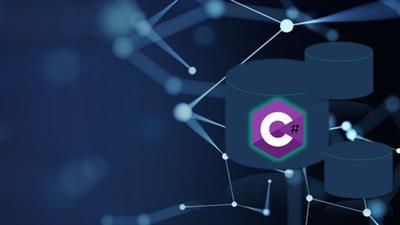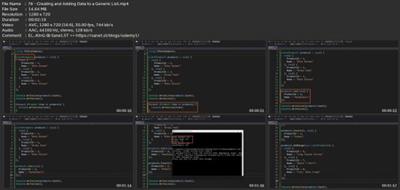
[center]Published 12/2022
MP4 | Video: h264, 1280x720 | Audio: AAC, 44.1 KHz
Language: English | Size: 852.18 MB | Duration: 2h 30m
Learn the skills you need to become proficient at C# object-oriented programming[/center]
What you'll learn
Use Properties and Methods for Proper Class Design
Use inheritance to cut down the amount of code you need to write
Learn to control the visibility and the lifetime of data
Raise and consume events from your classes
Eliminate multiple methods by using a generic method
Learn to manipulate generic collections
Create your own class libraries for a proper N-Tier application
Requirements
I assume you are familiar with the basics of the C# language and .NET.
Description
When programming C#, or any .NET language for that matter, Object-Oriented Programming (OOP) is a required skill. This course provides you with the skills you need to master OOP in C#. In this course you are given a high-level overview of OOP terms before you drill down into each concept.Creating classes with properties and methods is the first step in understanding OOP. Next, you learn how to use inheritance effectively to reduce the amount of code you write. Best practices around the scope of variables, classes, properties, and methods are also illustrated with several demos. Creating your own generic methods and classes will also greatly reduce the amount of code you need to write. Using the built-in .NET generic collections makes working with sets of data a breeze. Finally, you learn how to create your own class libraries.All the demos you are shown during this course are backed up with a set of labs for you to perform. Walking through these labs step-by-step ensures that you understand the concepts illustrated in each lesson. You are going to see over 40 demos, be asked over 30 questions, and perform over 30 hands-on labs.Join Paul D. Sheriff, one of the best instructors in the industry, on your journey to learning to an OOP C# developer.
Overview
Section 1: C# OOP Fundamentals Class Preview
Lecture 1 C# OOP Fundamentals Class Preview
Section 2: Introduction to Object-Oriented Programming
Lecture 2 What is a Class?
Lecture 3 What is an Object?
Lecture 4 Properties, Methods and Access Modifiers
Lecture 5 Namespaces and Events
Lecture 6 Static vs Instance
Lecture 7 Constructors, Destructors and Unmanaged Resources
Section 3: Use Properties to Hold Data in Your Classes
Lecture 8 Property Naming and Syntax
Lecture 9 Create a Console Application
Lecture 10 Create Auto-Properties in a Product Class
Lecture 11 Alternate Method of Instantiating and Initializing Objects
Lecture 12 Create a Full Property
Lecture 13 Create a Read-Only Property
Lecture 14 Use an Expression Body Definition
Lecture 15 Self-Paced Lab: Create application and Product class and add properties to class
Lecture 16 Resource: Finished Lab Samples
Lecture 17 Resource: Sample Code Demonstrated in Section
Section 4: Manipulate Property Data Using Methods
Lecture 18 Using and Naming Methods
Lecture 19 Create a Void Method
Lecture 20 Create a Method to Return a Value
Lecture 21 Create Constructors to Initialize Data
Lecture 22 Use Constants for Hard-Coded Data
Lecture 23 Parameters, Arguments and Overloading
Lecture 24 Optional Parameters
Lecture 25 Named Parameters
Lecture 26 Passing Arguments to a Constructor
Lecture 27 Call Parameters by Value
Lecture 28 Call Parameters by Reference
Lecture 29 Using Output Parameters
Lecture 30 Self-Paced Lab: Add methods to class, create constructors and pass parameters.
Lecture 31 Resource: Finished Lab Samples
Lecture 32 Resource: Sample Code Demonstrated in Section
Section 5: Inheritance Makes it Easy to Reuse Code
Lecture 33 Inheritance Terminology
Lecture 34 Create a Person Class
Lecture 35 Inherit from the Person Class
Lecture 36 Override the ToString() Method
Lecture 37 Override Your Own Method
Lecture 38 Create a Customer Class that Inherits from Person
Lecture 39 Self-Paced Lab: Create a class, inherit from it and override methods.
Lecture 40 Resource: Finished Lab Samples
Lecture 41 Resource: Sample Code Demonstrated in Section
Section 6: Additional Inheritance Concepts
Lecture 42 Interface Inheritance
Lecture 43 Demonstration of Interface Inheritance
Lecture 44 Working with Abstract Classes
Lecture 45 Stopping Inheritance Using a Sealed Class
Lecture 46 What Type of Inheritance to Use?
Lecture 47 Self-Paced Lab: Create an interface and a abstract class.
Lecture 48 Resource: Finished Lab Samples
Lecture 49 Resource: Sample Code Demonstrated in Section
Section 7: Control the Visibility and Lifetime of Data
Lecture 50 Scope and Access Modifiers
Lecture 51 Block Level Scope of Variables
Lecture 52 Method Level Scope
Lecture 53 Class Level Scope of Variables
Lecture 54 Protected Scope of Variables
Lecture 55 Scope of Methods
Lecture 56 Scope of Classes
Lecture 57 The Static Modifier
Lecture 58 Create a Static Class
Lecture 59 Create a Partial Class
Lecture 60 Self-Paced Lab: Control the scope of variables and methods and use static
Lecture 61 Resource: Finished Lab Samples
Lecture 62 Resource: Sample Code Demonstrated in Section
Section 8: Raising and Consuming Events
Lecture 63 Create an Event in a Class
Lecture 64 Consume an Event Raised from a Class
Lecture 65 Create a Custom EventArgs Class
Lecture 66 Consume and Use Data From Custom EventArgs Class
Lecture 67 Self-Paced Lab: Create and Consume Events from a Class
Lecture 68 Resource: Finished Lab Samples
Lecture 69 Resource: Sample Code Demonstrated in Section
Section 9: Generics Eliminate Code Bloat
Lecture 70 What is a Generic and Why Use Them
Lecture 71 Demonstration of Not Using Generics
Lecture 72 Create Generic Method to Replace Multiple Methods
Lecture 73 Creating and Using a Generic Class
Lecture 74 Self-Paced Lab: Creating and Using Generics
Lecture 75 Resource: Finished Lab Samples
Lecture 76 Resource: Sample Code Demonstrated in section
Section 10: Generic Collections Provide Great Features
Lecture 77 Features of Collections and the Limitations of Arrays
Lecture 78 Creating and Adding Data to a Generic List
Lecture 79 Remove Data From a Generic List
Lecture 80 Find an Item in a Generic List Using a Lambda Expression
Lecture 81 Extract a Subset of Data Using a Lambda Expression
Lecture 82 Self-Paced Lab: Practice Working with Generic Collections
Lecture 83 Resource: Finished Lab Samples
Lecture 84 Resource: Sample Code Demonstrated in section
Section 11: Create Your Own Class Libraries
Lecture 85 The Most Common Types of Class Libraries to Create
Lecture 86 How Each Type of Class Library is Used
Lecture 87 Advantages of Class Libraries and a Common Library
Lecture 88 Create the Common Class Library
Lecture 89 What to Put into MVC and WPF Class Libraries
Lecture 90 Self-Paced Lab: Creating Class Libraries
Lecture 91 Resource: Finished Lab Samples
Lecture 92 Resource: Sample Code Demonstrated in section
Any developer wishing to develop in the .NET framework with C# should take this course.,If you are going to develop Web, Cloud, Mobile, Games, Internet of Things (IoT), or Desktop applications, OOP is a required skill.,Any manager or QA person who needs to communicate better with their programming team should also take this course.

download скачать link
rapidgator.net:
https://rapidgator.net/file/ab418e64fec1b64b27ec81c9be8c6758/knjnc.C.ObjectOriented.Programming.Fundamentals.rar.html
uploadgig.com:
https://uploadgig.com/file/download скачать/1eb145e14584363b/knjnc.C.ObjectOriented.Programming.Fundamentals.rar
nitroflare.com:
https://nitroflare.com/view/1ABCF105DA04A01/knjnc.C.ObjectOriented.Programming.Fundamentals.rar
1dl.net:
https://1dl.net/iqhdtx1p5nhj/knjnc.C.ObjectOriented.Programming.Fundamentals.rar

